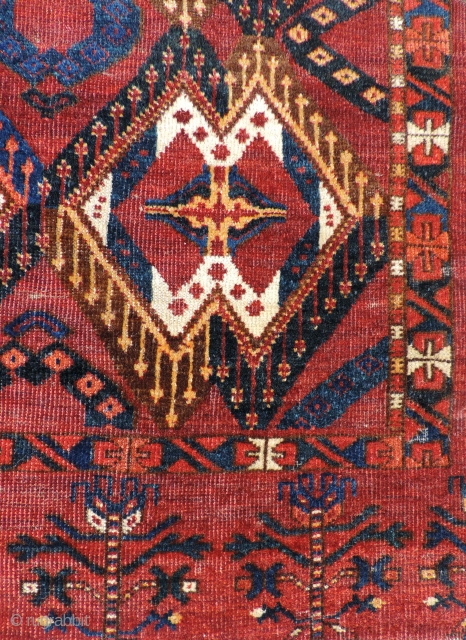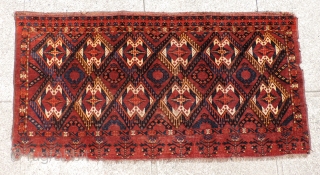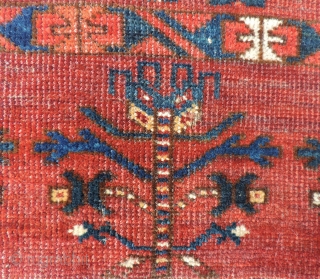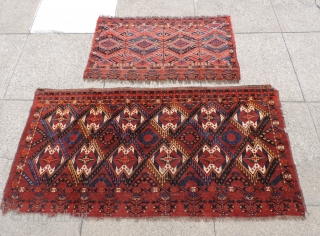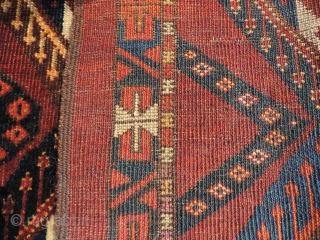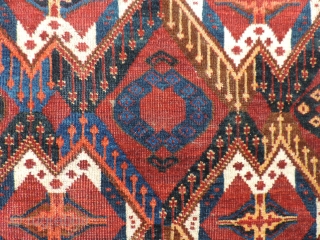Back
Absolutely enormous Turkmen trapping or storage bag of monumental scale. This piece is old with great colors. See the image that compares it to a standard sized juval of the same group. Both pieces share similarly designed elems and top panels. This one is substantially older though. Made in the Middle Amu Darya region. Size: 88 x 45 inches - 224 x 114 cm. It is hard to know its exact purpose or to imagine something this large, full and needing to be loaded onto a camel for transport. It doesn't currently have a back and since it is missing a little along the bottom it is not clear if it ever had one. If it was made as a wedding trapping- meant to be draped over the bride's litter (kejebe) or camel as part of the dowry, then it was probably made for an important family. The only other Turkmen trappings of this scale are a few famous 18th century or earlier Salor trappings with the 'darvaza' gul (Hoffmeister, Weidersperg examples) which are otherwise unrelated except that they could also come from the Middle Amu Darya region. If this piece had been a storage bag of some type (which were always made in pairs) there would have been more work in such a set than in most main carpets - when the backs are included. It certainly would have required a main carpet-width loom to weave this giant. The design is familiar, seen in Turkmen pieces of the region and often compared to Central Asian ikat designs and is not unlike that seen in some reed screens made by the Kirghiz tribes. This weaving has at least ten colors including a very limited use of a corroded insect dyed silk in the minor border. The pile is soft and lush in some areas and evenly low in others, but it is not skinned to the knot tops as is often seen and reads well. It has rich, deep mahogany red ground and lustrous wool and the handle is supple even though the weave has a bit of depression. Knots are asymmetrical, open right. Warps and wefts are mixed brown/grey goat hair. The top has it's original flatwoven end folded over and sewn down and the selvedges are wrapped with brown goat hair over three groups of three warps. There are a few areas where moths got to it on one edge, but no reweaves. It needs a little stabilization work in a couple of places. It's possible that I've seen one of these giants before over my many years in this field, but if so, it wasn't as old or as beautiful as this one or i would have remembered it. Whatever this was, it remains a very beautiful, very impressive, soulful old Turkmen weaving.
price:
SOLD
- Home
- Antique Rugs by Region
- Category
- Profiles
- Post Items Free
- Albums
- Benaki Museum of Islamic Art
- Budapest: Ottoman Carpets
- Gulbenkian Museum
- Islamic Carpets. Brooklyn
- Islamic Textiles. Brooklyn
- Konya Museum: Rugs
- MKG, Hamburg
- MMA: Caucasian Carpets
- MMA: Mamluk Carpets
- MMA: Mughal Indian Carpets
- MMA: Ottoman Carpets
- MMA: Safavid Persian Carpets
- MMA: Turkmen Rugs
- McCoy Jones Kilims
- Ottoman textiles. Met
- Philadelphia Museum
- Rugs and Carpets: Berlin
- Seljuqs at the Met
- TIEM, Istanbul: Carpets
- V&A: Classical Carpets
- Vakiflar Carpets: Istanbul
- Baluch Rugs: Indianapolis
- Gallery Exhibitions
- Jaf an Exhibition
- Alberto Levi Gallery
- Andean Textile
- Christie's London: 2016
- Francesca Galloway
- HALI at 40
- ICOC Washington, DC 2018
- Jajims of the Shahsavan
- London Islamic Week April, 2018
- Mongolian Felts
- Navajo Rugs: JB Moore
- Persian Piled Weavings
- SF Tribal & Textile Art Show 2020
- SF Tribal 2019
- Sotheby's: C. Alexander
- Turkish Prayer Rugs
- Turkmen Main Carpets ICOC 2007








